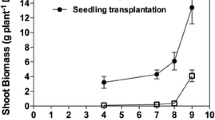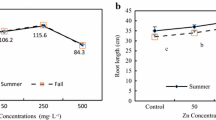Abstract
Background, aim, and scope
Zinc is an essential micronutrient element but its concentrations found in contaminated soils frequently exceed those required by the plant and soil organisms, and thus create danger to animal and human health. Phytoremediation is a technique, often employed in remediation of contaminated soils, which aims to remove heavy metals or other contaminants from soils or waters using plants. Arabidopsis (A.) halleri ssp. gemmifera is a plant recently found to be grown vigorously in heavy metal contaminated areas of Japan and it contained remarkably high amount of heavy metals in its shoots. However, the magnitude of Zn accumulation and tolerance in A. halleri ssp. gemmifera need to be investigated for its use as a phytoremediation plant.
Materials and methods
A. halleri ssp. gemmifera was grown for 3 weeks into half-strength nutrient solution with Zn (as ZnSO4) levels ranging from 0.2 to 2,000 µM. The harvested plants were separated into shoots and roots, dried in the oven, and ground. The plant tissue was digested with nitric-perchloric acid, and the Zn concentration in the digested solution was measured by atomic absorption spectrophotometer.
Results and discussion
The results showed no reduction in shoot and root dry weight when plants were grown at 0.2 to 2,000 µM Zn in the solution. The highest Zn concentration measured in the shoots was 26,400 mg kg-1 at 1,000 µM Zn, while in the roots, it was 71,000 mg kg-1 at 2,000 µM Zn treatment. Similar to the Zn concentration in plant parts, maximum Zn accumulation of 62 mg plant-1 in the shoots and 22 mg plant-1 in the roots was obtained at 1,000 and 2,000 µM Zn in the solution. The percentage of Zn translocation in shoot varied from 69% to 90% of the total Zn, indicating that the shoot was the major sink of Zn accumulation in this plant.
Conclusions
The results of this study indicate that the growth of A. halleri ssp. gemmifera was not affected by the Zn level of up to 2,000 µM in the nutrient solution. The concentration of Zn found in shoot indicated that A. halleri ssp. gemmifera has an extraordinary ability to tolerate and accumulate Zn and hence a good candidate for the phytoremediation of Zn-polluted soil.
Recommendations and outlook
Based on the results presented in this study and earlier hydroponics, and field study, A. halleri ssp. gemmifera seems to be a potential heavy metals hyperaccumulator, and could be recommended to use for phytoremediation of Cd- and Zn-contaminated soils.
Similar content being viewed by others
References
Baker AJM, Reeves RD, Hajar ASM (1994) Heavy metal accumulation and tolerance in British populations of the metallophyte. Thlaspi caerulescens J. & C. Presl (Brassicaceae). New Phytol 127:61–68
Kashem MA, Singh BR, Kubota H, Nagashima RS, Kitajima N, Kondo T, Kawai S (2007) Assessing the potential of Arabidopsis halleri ssp. gemmifera as a new cadmium hyper accumulator grown in hydroponics. Can J Plant Sci 87:499–502
Kubota H, Takenaka C (2003) Arabis gemmifera is a hyperaccumulator of Cd and Zn. Int J Phytoremediat 5:197–201
Minitab (1992) Minitab handbook, 2nd edn. State College, PA
Qiu R, Fang X, Tang Y, Du S, Zeng X, Brewer E (2006) Zinc hyperaccumulation and uptake by Potentilla Griffithii Hook. Int J Phytoremediat 8:29–310
Reeves RD, Baker AJM (2000) Metal accumulating plants. In: Raskin I, Ensley BD (eds) Phytoremediation of toxic metals: using plants to clean up the environment. Wiley, New York, pp 193–229
Shen ZG, Zhao FJ, McGrath SP (1997) Uptake and transport of zinc in the hyperaccumulator Thlaspi caerulescens and the non-hyperaccumulator Thlaspi ochroleucum. Plant Cell and Environ 20:898–906
Yang XE, Li TQ, Long XX, Xiong YH, He ZL, Stoffella PJ (2006) Dynamics of zinc uptake and accumulation in the hyperaccumulating and non-hyperaccumulating ecotypes of Sedum alfredii Hance. Plant and Soil 284:109–119
Zhao FJ, Lombi E, Breedon T, McGrath SP (2000) Zinc hyperaccumulation and cellular distribution in Arabidopsis halleri. Plant Cell Environ 23:507–514
Acknowledgements
The senior author thanks the Japan Society for the Promotion of Science (JSPS) for providing him a Postdoctoral fellowship to conduct this research work.
Author information
Authors and Affiliations
Corresponding author
Rights and permissions
About this article
Cite this article
Kashem, M.A., Singh, B.R., Kubota, H. et al. Zinc tolerance and uptake by Arabidopsis halleri ssp. gemmifera grown in nutrient solution. Environ Sci Pollut Res 17, 1174–1176 (2010). https://doi.org/10.1007/s11356-009-0193-6
Received:
Accepted:
Published:
Issue Date:
DOI: https://doi.org/10.1007/s11356-009-0193-6




